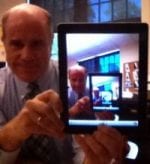Marty: Alright Doc, what’s going on, huh? Where are we? When are we?
Doc: (looking at the time display) We are descending towards Hill Valley, California, at 4.29pm, on Wednesday, October 21st, 2015.
Marty: 2015? You mean we’re in the future?
We are in my future. When Back to the Future II was released in Fall 1989, I had just completed my first full year teaching, at Hackley. There was no Internet and no truly “mobile” phones (just clunky portable phones the size and weight of a brick) let alone “smart” phones. Personal computers were expensive and rare.
On the eve of October 21, 2015, I tried to share the tech reality of the pre-digital era with seniors at a Chapel Talk. While Spielberg and Zemeckis’ expectations were grander, the rate of technological change in the past 30 years is striking. Consider these rough time frames of our tech eras:
The Stone Age lasted 3.4 million years. The Bronze, Iron and Medieval Ages: 1200-2000 years. The Enlightenment: 200. The Industrial/Electrical Age: 100. The Transistor Age: 50 years.
In 1982, Time magazine marked the start of the Information age, naming the personal computer “Machine of the Year.” The Digital Age, however, has come about during the lifetime of Hackley’s seniors. The iPod and iTunes launched in 2001. Facebook: 2004. YouTube, 2005 and Twitter, 2006. The iPhone arrived in 2007. Kodak stopped production of Kodachrome film in 2009, the same year TV transmissions went digital. 2010: the iPad.
To illustrate the stark rapidity of change, I filled the chapel with my collection of analog “relics,” tools since replaced by digital equivalents on their smartphones. I illustrated the origin of the PowerPoint “slide” by demonstrating an actual slide show from a carousel slide projector and asked if they knew how to “dial” a rotary phone, where the term “dialing the number” derives.
While an iPhone may take better pictures than my Kodak Instamatic, analog and digital are not the same. Film cameras, Bell telephones and magnetic tape captured and transmitted every aspect of recorded events. Today’s digital equivalents capture and transmit mathematical interpretations of those events. Digital software converts live events into binary code, often using algorithms to enhance them. A digital representation is composed of “digits”– a numeric translation of a live event. There is always, deep down in that code, a gap between those 1’s and 0’s .
I hoped the seniors would realize the real differences between these analog devices and the powerful tool they carried around in their pockets and gain some digital skepticism. More important, though, given continuing exponential growth happening in their lifetime, I challenged them to embrace and be agents of change in their future: Class of 2016, where’s my flying car?
